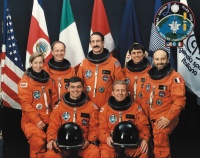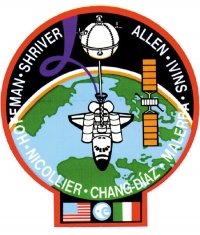STS-46
From The Space Library
 | |
| Organization | NASA-Office of Space Flight (United States) |
|---|---|
| Mission type | Human Crew |
| Launch date | July 31, 1992 |
| Launch vehicle | Space Shuttle |
| Launch site | Cape Canaveral, United States |
| COSPAR ID | 1992-049A |
| Inclination | 28.45 degrees |
| Experiments | Here |
| Alternate Names | 22064 |
| Additional Information | Here |
| Data Collection | Here |
| Payload Mass Up | 12965 kg |
| Payload Mass Down | 8451.82 kg |
| Orbiter | Atlantis |
| Lift Off Mass | 2,053,085.91 kg |
| Orbiter Weight at Liftoff | 116,377.73 kg |
| Orbiter Weight at Landing | 94,911.82 kg |
| Landed | Runway 33 at Kennedy Space Center, Fla. |
| Orbits of Earth | 127 |
| Orbital Altitude | 127 nautical miles (146 statute miles) |
Contents |
[edit] Crew
- Commander: Loren J. Shriver
- Pilot: Andrew M. Allen
- Payload Commander: Jeffrey A. Hoffman
- Mission Specialist 1: Franklin R. Chang-Diaz
- Mission Specialist 2: Claude Nicollier
- Mission Specialist 3: Marsha S. Ivins
- Mission Specialist 4:
- Mission Specialist 5:
- Payload Specialist 1: Franco Malerba
- Payload Specialist 2:
ISS/Mir Crew Transport
[edit] Mission
STS 46 was the 49th shuttle mission and the 12th flight of the Atlantis orbiter. It carried a crew of seven. The Shuttle was to deploy the Tethered Satellite System-1 (TSS-1), an Italian Space Agency-developed satellite. The satellite was to have been attached by a 12.5 mile cable to the Shuttle cargo bay to explore the dynamics of electricity-generating systems. However, attempts by the crew to release the cable failed and the experiment was unsuccessful. The European Retrievable Carrier (EURECA), developed by the European Space Agency (ESA), was deployed. The satellite, carrying 15 experiments in material science, life science and space physics and upper atmosphere research, was retrieved by STS 57 a year later. The following experiments were also carried by STS-46: (1) Evaluation of Oxygen Interaction with Materials III (EOIM); (2) Thermal Energy Management (TEMP 2A); (3) IMAX camera production; (4) materials processing experiments; (5) Limited Duration Space Environment Candidate Materials Exposure (LDCE); (6) Pituitary Growth Hormone Cell Function (PHCF); (7) Air Force Maui Optical System (AMOS); and, (8) Ultraviolet Plume Experiment (UVPI). The orbiter landed at Kennedy Space Center after completing 127 orbits. The mission duration was 7 days, 23 hours, 15 minutes, and 3 seconds.
[edit] EVA
[edit] Payload
Tethered Satellite System (TSS)-1; European Retrievable Carrier (EURECA)-1L; Evaluation of Oxygen Integration With Materials (EOlM)-lll/ Thermal Energy Management Processes (TEMP)-2A; Consortium for Materials Development In Space Complex Autonomous Payloads (CONCAP)-ll and Ill; IMAX Cargo Bay Camera (ICBC); Limited-Duration Space Environment Candidate Materials Exposure (LDCE); Pituitary Growth Hormone Cell Function (PHCF); Ultraviolet Plume Instrument (UVPl)
[edit] Books about the Space Shuttle Program
Buy This Book Click here |
Buy This Book here |
Buy This Book Click here |
Buy This Book Click here |





